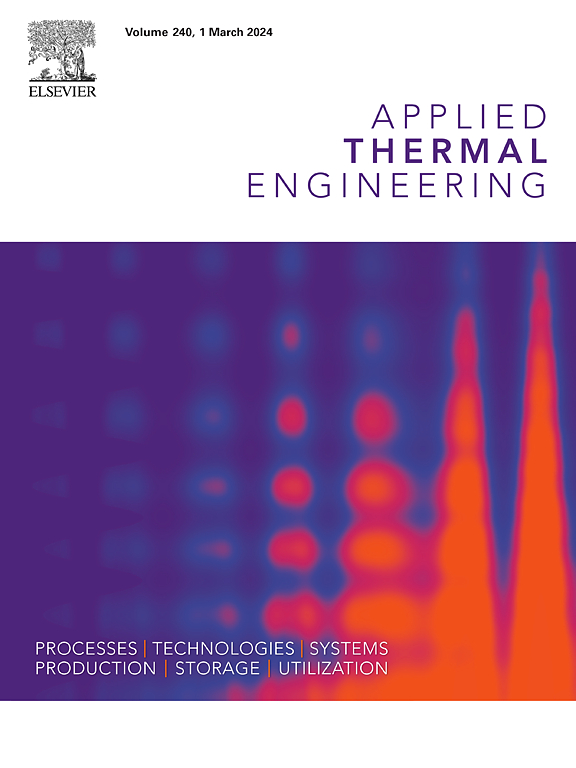水箱温度对太阳能辅助多源热泵干燥系统性能影响的研究与优化
IF 6.9
2区 工程技术
Q2 ENERGY & FUELS
引用次数: 0
摘要
太阳能辅助空气源热泵干燥(SASHPD)系统因其出色的节能效果和较高的干燥产品质量而被广泛研究。为了提高系统性能,本文研究了太阳能辅助多源热泵干燥(SMSHPD)系统的控制逻辑,并建立了仿真模型和实验平台。研究了空气源热泵干燥(ASHPD)、太阳能辅助多源热泵干燥(SASHPD)和太阳能辅助多源热泵干燥(SMSHPD)模式的季节运行特性。计算并分析了三种干燥系统的能耗、性能系数(COP)和特定抽湿率(SMER)。此外,还测量了水箱温度,以确定干燥系统的季节控制逻辑。结果发现,与 ASHPD 系统相比,SASHPD 系统在夏季的能耗降低了 33.06%,COP 和 SMER 分别提高了 49.4% 和 49.38%。此外,由于环境温度和水箱温度较高,实验结果表明夏季只应采用 SASHPD 控制逻辑。模拟结果的最大误差为 9.1%,证明了模拟模型的准确性。在秋季,干燥后的水箱温度较低,说明太阳能可以得到更充分的利用,这也解释了为什么 SMSHPD 模式的性能比 SASHPD 模式提高了 6.5%。因此,有必要在秋季实施 SMSHPD 控制逻辑。此外,还对秋季水源热泵干燥模式的运行温度进行了优化,最佳温度范围为 28-54 °C。优化后一周内的平均 COP 比原始运行温度高出 6.21 %。根据验证后的仿真模型,还计算出了春季和冬季的最佳运行温度,并得到了 SMSHPD 系统在四季运行的控制逻辑。本文对于合理选择太阳能组合式空气源热泵干燥系统的控制逻辑具有重要的指导意义。本文章由计算机程序翻译,如有差异,请以英文原文为准。
Study and optimization of the influence of the water tank temperature on the performance of a solar assisted multi-source heat pump drying system
Solar assisted air source heat pump drying (SASHPD) system has been widely studied due to its excellent energy saving and high dried quality of product. To improve system performance, the control logic of a solar assisted multi-source heat pump drying (SMSHPD) system was investigated, and the simulation model and the experimental platform were established in this paper. The seasonal operating characteristics of the air source heat pump drying (ASHPD), the SASHPD and the SMSHPD modes were studied. The energy consumption, coefficient of performance (COP) and specific moisture extraction rate (SMER) of the three drying systems were calculated and analyzed. Additionally, the water tank temperature were also measured to determine the seasonal control logic of the drying system. It was found that compared to the ASHPD system, in summer, the energy consumption of the SASHPD system was reduced by 33.06 %, and COP and SMER was increased by 49.4 % and 49.38 %, respectively. Moreover, because of the high ambient temperature and water tank temperature, the experimental results indicated that only the SASHPD control logic should be implemented in summer. The maximum error of the simulation results was 9.1 % and the accuracy of the simulation model was confirmed. In autumn, the lower water tank temperature after drying illustrated that the solar energy can be more fully utilized, which explained why the performance of the SMSHPD mode was increased by 6.5 % compared to the SASHPD mode. Consequently, it is necessary to implement the SMSHPD control logic in autumn. Moreover, the operating temperature of the water source heat pump drying mode in autumn was optimized and the optimal temperature range was 28–54 °C. The average COP in one week after optimization was 6.21 % higher than that of the original operating temperature. Based on the validated simulation model, the optimal operating temperatures in spring and winter were also calculated and the control logic of the SMSHPD system operating in the four seasons were all obtained. This paper has important guiding significance for the reasonable choice of the control logic of a solar combined air source heat pump drying system.
求助全文
通过发布文献求助,成功后即可免费获取论文全文。
去求助
来源期刊

Applied Thermal Engineering
工程技术-工程:机械
CiteScore
11.30
自引率
15.60%
发文量
1474
审稿时长
57 days
期刊介绍:
Applied Thermal Engineering disseminates novel research related to the design, development and demonstration of components, devices, equipment, technologies and systems involving thermal processes for the production, storage, utilization and conservation of energy, with a focus on engineering application.
The journal publishes high-quality and high-impact Original Research Articles, Review Articles, Short Communications and Letters to the Editor on cutting-edge innovations in research, and recent advances or issues of interest to the thermal engineering community.
 求助内容:
求助内容: 应助结果提醒方式:
应助结果提醒方式:


